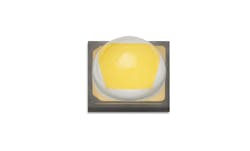Lumileds packaged CSP LED delivers enhanced optics for high lumen needs
Lumileds has announced the Luxeon HL2X packaged LED designed for high-lumen-output applications including street lights and high-bay luminaires. The highly-directional LEDs deliver advantages in solid-state lighting (SSL) applications where all of the produced photons are delivered in a target area. The LED architecture uses a unique combination of a chip-scale package (CSP) LED — essentially a die — that is placed in a traditional high-power package that allows the addition of a dome-shaped primary optic.
With the launch of the HL2X LED, we again see an example of a component intended to improve quality of light, and that’s a theme we have stressed in the SSL sector going back a couple of years. The applications for which the new Lumileds family is intended aren’t particularly requisite of the highest quality in terms of, say, color rendering. But light quality is measured in many ways and always the best measure is relative to the application. Area lighting outdoors and high-bay lighting indoors deliver higher application efficacy when the beam is well controlled. Moreover, the uniformity afforded by good optical design makes it easier for someone outdoors to recognize another person as friend or threat or workers indoors to see their task more easily.
The unique aspect of the HL2X that struck us immediately was the integration of a CSP into a traditional package. We have covered CSPs going back several years with Lumileds being the first to announce such a product at our Strategies in Light event back in 2013. We published a foundational article on CSP technology in 2015.
The value proposition for CSP technology was elimination of packaging steps and more scalability across an LED family. CSP LEDs are not packaged onto a substrate typically. Instead, the primary packaging step is adding electrical and thermal contacts in the back end of the wafer/die manufacturing process. Such LEDs essentially match the footprint of the bare LED die. SSL manufacturers must have advanced printed-circuit board (PCB) assembly capabilities to work with CSP LEDs, but can potentially achieve cost savings and perhaps better performance depending on the system design.
In the Lumileds case, the company has achieved manufacturing efficiency developing the CSP product in a manner that works equally well for manufacturers pursuing CSP, direct-attach product designs and for use in their high-power LED offering. The HL2X utilize the HL1 CSP product announced in the fall of 2019. That product was nominated to our 2020 Sapphire Awards program and earned 3.5 Sapphires.
The integration of the CSP into the package also enabled Lumileds to add the primary optic and that optic is essential in delivering the uniformity that Lumileds is citing as a major advantage of the product. “With 318 plus lumens at 700 mA and 85°C, Luxeon HL2X delivers more field usable lumens for optical engineers to work with,” said Alvin Yeoh, senior product marketing manager. “Lumileds’ attention to beam angle, field angle, color over angle, and optical efficiency gives engineers more lumens to work with and better quality of light than has been previously possible.”
The CSP LED that’s the basis of the new product is just over 1.4 mm per side. The packaged LED measures 3.5×3.5 mm and has a footprint including contacts and thermal pad that match the popular Luxeon TX LED. Product developers will be able to easily upgrade to the new LED and improve performance in their existing designs.
Initially, Lumileds is offering the HL2X at CCTs from 2700K to 6500K and CRI of 70. That relatively low CRI is the standard in the intended applications and enables higher levels of efficacy. Lumileds said it would add 80- and 90-CRI options for applications that require such color quality. At 700 mA of drive current, efficacy ranges from 141 to 158 lm/W depending on CCT. Of course, product developers can drive the LEDs at higher currents, trading off efficacy.
For up-to-the-minute LED and SSL updates, why not follow us on Twitter? You’ll find curated content and commentary, as well as information on industry events, webcasts, and surveys on our LinkedIn Company Page and our Facebook page.

Maury Wright | Editor in Chief
Maury Wright is an electronics engineer turned technology journalist, who has focused specifically on the LED & Lighting industry for the past decade. Wright first wrote for LEDs Magazine as a contractor in 2010, and took over as Editor-in-Chief in 2012. He has broad experience in technology areas ranging from microprocessors to digital media to wireless networks that he gained over 30 years in the trade press. Wright has experience running global editorial operations, such as during his tenure as worldwide editorial director of EDN Magazine, and has been instrumental in launching publication websites going back to the earliest days of the Internet. Wright has won numerous industry awards, including multiple ASBPE national awards for B2B journalism excellence, and has received finalist recognition for LEDs Magazine in the FOLIO Eddie Awards. He received a BS in electrical engineering from Auburn University.





